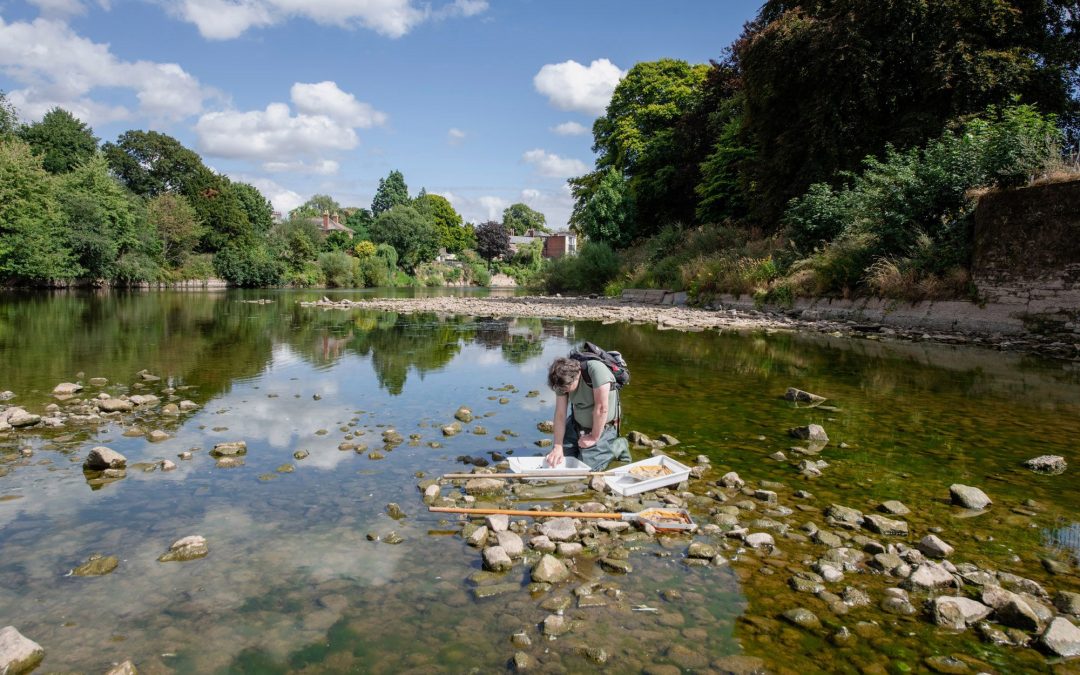New analysis by Herefordshire Wildlife Trust shows that in October 2022 the average level of the River Wye at Ross-on-Wye was 54cm, barely half its historic (2013-2021) average at this location in the month of October, which is 94cm. This means that despite the rain, the Wye is still a lot lower than average.
Wildlife experts are concerned that long-running low river levels could impact species in the river and the wider county. On the other hand, in order to compensate for the drought, significant rainfall would be needed which could cause flooding and inundate the river with soil washed off fields.
According to the Environment Agency’s latest Dry weather brief (11 November) the West Midlands are still officially in drought, despite the rain seen in recent weeks.
The ongoing low river levels, and dry conditions, could continue to affect wildlife into next year:
Many insect species spend part of their lifecycle in the water, if there isn’t enough water then they will die before reaching adulthood.
Low water levels affect the ability of aquatic species to move about, this is especially important for the atlantic salmon that travels up the Wye and Lugg rivers to spawn. Events like floods trigger migration or spawning and if flooding doesn’t occur or water temperatures don’t reach a certain level then this will throw species’ life cycles off course and affect populations the following year
If vegetation on the river banks can’t recover from the dry summer then this impacts food sources and shaded areas for fish spawning
If there isn’t enough foliage for caterpillars to feed on then the butterfly populations the following year will be impacted
If wetlands dry out then wader species may struggle to find food, especially crucial around breeding time as it will lead to lower breeding success
A run of dry weather began in 2021, with the River at Ross-on-Wye at just 0.47m on 13 October in that year with terrifyingly low levels seen in the summer of 2022: in September, at the same site, the level was a mere 8 centimetres.
The pollution of the Wye which has repeatedly made national headlines is made worse by drought as low levels of water in the rivers mean that the pollutants become more concentrated, this affects the resilience of species and triggers species decline.
High phosphate levels can cause algal blooms which can shade out other aquatic plants and when it dies the algae drops to the bottom of the river and smothers gravel beds. Algae also strips oxygen from the water which can cause fish deaths. The pollution has also led to a massive decline in an important aquatic plant called water crowfoot, an essential part of the river ecosystem. Once extensive beds of water crowfoot which provided habitat for huge numbers of invertebrates as well as nursery areas for small fish, are now largely lost from the Wye.
A further concern now, as we start to see heavy rainfall, is that droughts followed by flash floods can release a lot of additional phosphate that had been locked away in the soil into the watercourses.
Jamie Audsley, Chief Executive of Herefordshire Wildlife Trust, said:
“This year our beloved River Wye dried up to a trickle. It’s hard to see how it can be a home for wildlife as climate change changes our weather. The rain we’ve had is nowhere near enough to get us out of drought. But as climate change affects our weather, we’ll be locked into a cycle of droughts that can only be ended by extreme rain and flooding. This will have a big impact on wildlife.
“The Wye is facing a double whammy of problems – when it’s not dried out, it’s being inundated by pollution that’s killing its fish, birds, and insects. Farming is currently responsible for over 60% of the pollution in the Wye – that’s why we’re working as hard as we can with farmers to introduce more sustainable techniques to the county, and why we’re urging the Government to press ahead with a new nature-friendly system that will reward farmers.”
Claire Spicer, Head of Conservation at Herefordshire Wildlife Trust said:
“Right now, groundwater is at the lowest point it has been and will not properly recover for some years. With unseasonal weather and extreme weather events increasingly becoming the norm, individuals and businesses need to be looking at ways to adapt to climate change and, in particular, periods of low rainfall. On farms, ponds can be created to collect surface water run-off from clean yards and roofs and used to water livestock and plants during the drier months. Trees can be planted to create shade for wildlife. In addition to developing good soil health on farms, planting mixed variety crops, mulching and under-sowing will help arable farmers in the years ahead.”
Will Watson, ecologist said:
“I conducted a survey of the River Wye on 23rd August 2022 below the Old Wye Bridge in Hereford. The river appeared extremely impoverished. Downstream I found algal blooms on the rocky shallows and algae covering the rocks. I also noticed algae covering the spiked water milfoil. Where once there were beds of river water-crowfoot in flower helping to cool the water, now all I could find were just a few plants left on the river bed. A pike had recently died, presumably from low oxygen levels. The river is going to take a long time to fully recover.”




